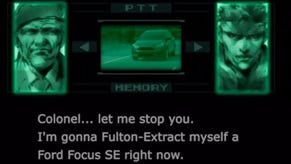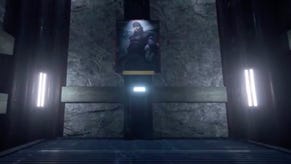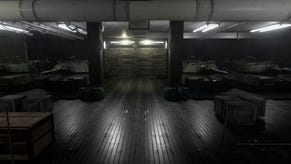Metal Gear Solid HD Collection Review
Of mullets and men.
Editor's note: Metal Gear Solid HD Collection is released in Europe this week. Here we present our review of the North American release of the game, first published in November last year. To the best of our knowledge it's still accurate with respect to the European version.
Metal Gear Solid's Snakes may resemble Escape From New York's hero right down to their names and eventual eye patch; however, their penchant for ideological musing about the nature of war reminds me more of another mulleted eighties action hero, Dalton, the bouncer with a philosophy PHD from Road House. And much like that 1989 cult classic, in Metal Gear Solid, it's never clear when the creators are in on the joke.
More esoteric and cerebral than the pro-war action movies from which they draw so heavily, Metal Gear Solid games are equal parts melodrama, political thriller, science-fiction, whimsical meta-humour and surreal theatrics. They're as much war games as Twin Peaks is a police procedural.
Often, their lengthy exposition is meandering, over-explaining simple facts ad nauseam while glossing over important twists in the labyrinthine plot. But just when you start tuning out, something will suddenly grab your attention like a guard alerted to Snake's presence. The games' tone varies from jaw-droppingly majestic - like a field of flower petals changing colors paired with a Harry Gregson-Williams score - to drawn-out philosophical debate or goofy comic relief. It's not always on point, but series creator Hideo Kojmia's schizophrenic sensibilities are never less than stimulating.
This HD collection brings together definitive editions of Metal Gear Solid 2: Sons of Liberty, 3: Snake Eater and the previously PSP-exclusive Peace Walker. Curiously, neither MGS3 nor Peace Walker actually stars series protagonist Solid Snake, and even MGS2 soon turns the spotlight off him. Both Snake Eater and its direct sequel Peace Walker are prequels set a generation before the series began, while MGS2 takes place nearly 30 years after Peace Walker. MGS2 likely won't make a whole lot of sense without the original Metal Gear Solid, but then, it probably won't make much sense anyway.
Regardless of this lack of cohesion, all three games (or five, rather, as the 8-bit Metal Gear and Metal Gear 2: Solid Snake are included as a bonus in Snake Eater) stand up as being some of the most daring and inventive titles to come about in the last decade.
Metal Gear Solid 2: Sons of Liberty
When Kojima pulled the rug out from under our feet by replacing Solid Snake with androgynous pretty-boy Raiden after MGS2's opening chapter, it set the tone for a series that continues to defy expectations.
"Graphically, times have not been kind to MGS2, even with the HD upgrade."
Sons of Liberty also takes Metal Gear Solid into the realm of the absurd. Early on, a villain from the previous game shows up possessed by the arm of your evil twin brother; a military weapon inexplicably resembles a giant mechanical lizard and even roars; and one of Raiden's mission control contacts is his girlfriend Rose, who continually brings up their relationship while he's supposed to be rescuing hostages. It often feels like Raiden and Rose are mere kids playing make believe, and one can't help but wonder how tongue-in-cheek it's meant to be.
Regardless of how you feel about the direction it took the series' narrative, MGS2 was vital for where it took the stealth action genre. It expanded Snake's move set exponentially, with the most game-changing addition being the ability to shoot in first-person. Of course, this has become the norm since, but at the time it was nothing short of revolutionary.
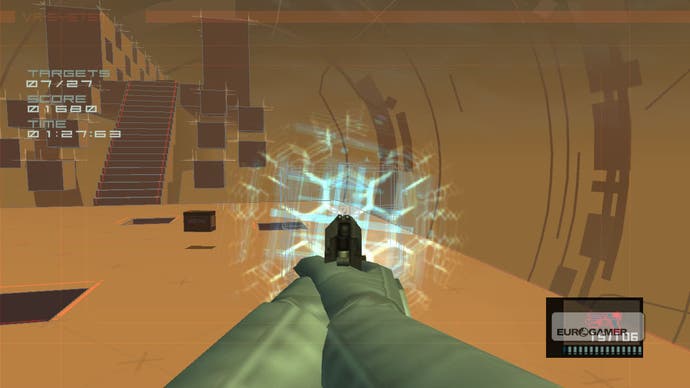
Today, the controls feel stiff, and the awkward, prescribed camera angles make for jarring transitions to first-person. This should be annoying, but a helpful radar and near-sighted enemies ensure that it's seldom unfair. Enemy AI is dim, unable to look across the Y-axis or hear your nimble agent running inches behind it. It feels like a precursor to Arkham City's stealth, where you're an overpowered force of nature, capable of incapacitating a roomful of enemies with ease.
In spite of MGS2's hoary mechanics, Kojima's eye for detail means it holds up remarkably well. Shoot an enemy's radio and it'll fizzle out, buying extra time before they can call in an alert.
Graphically, times have not been kind to MGS2, even with the HD upgrade, but its audio fills in the gaps that the visuals lack. The score continues to get the blood pumping and the exaggerated clicks of guns being loaded, juggled or readied adds excitement to the already over-the-top action set-pieces.
Sons of Liberty is an antique, but if you're willing to get to grips with its outmoded elements, the rewards are every bit as entertaining today as they were a decade ago.
Metal Gear Solid 3: Snake Eater
"After the manic storytelling of MGS2, Snake Eater reins it in for the most focused game in the series. It's also the best."
After the manic storytelling of MGS2, Snake Eater reins it in for the most focused game in the series. It's also the best.
This episode goes back 40 years to tell the story of Snake's father and his relationship with his mentor, The Boss, who'd recently defected to the Soviet Union under mysterious pretences. The early hours drag on with a poor cut-scene-to-play-time ratio, but once the stage is set, Snake Eater leaves you to play for hours on end with few substantial interruptions.
Thank God for that, as MGS3's stealth gameplay remains some of the finest available. This version is based on the "Subsistence" edition, allowing players full camera control with the right analogue stick. Being able to look ahead and peek around corners without leaning against a wall is a giant shift for the series, and a hugely convenient one at that.
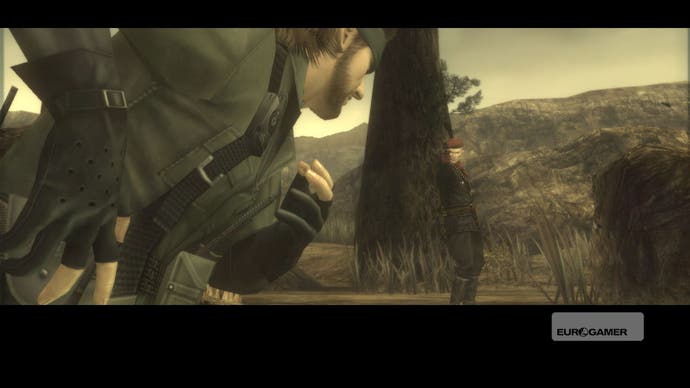
MGS3 also introduced camouflage. Since most of the game is set in the outdoors with few barriers to hide behind, you must discover your own hiding spots by frequently switching outfits to blend in with the surroundings. You'll spend a lot of time slithering through the grass, but the slow pace ratchets up the suspense. Miss a headshot by a millimetre and guards will be alerted and call in reinforcements unless you incapacitate them in the next split-second.
Aiming is easier than ever thanks to the HD upgrade. Snake Eater was always a gorgeous game, but aiming in first-person required pixel-perfect precision with realistically tiny grooves making up the MK22's iron sights. When dealing with something this exact, crisper edges make all the difference. Generally, HD upgrades look nicer but the gameplay ramifications are negligible. Not so here.
MGS3 also houses some of the best boss battles I've ever played, and many of my favourite moments in the series: a sniper duel in the forest; an otherworldly descent where you're haunted by ghosts of every character you've killed; a bizarre, vampire-themed dream sequence that I discovered by accident upon loading my game at a specific point. [Correction: This dream sequence, which we remember from a play-through of the original game, has apparently been cut from this version.]
Lavish enough to still astound today, while old enough not to conform to today's homogenized controls, Snake Eater carved a fine niche by pioneering a recipe for successful stealth in the most unlikely environments - brightly lit jungles. It's telling that MGS4's early chapter and the majority of Peace Walker try so hard to recreate Snake Eater's magic, yet neither have quite lived up to Big Boss' first starring role.
Metal Gear Solid: Peace Walker
"If anything, this collection highlights how much better Peace Walker could have been had it been developed for consoles from the get-go."
This isn't to suggest that its direct sequel, Peace Walker, didn't have its own ideas. Originally debuting on the PSP, it simultaneously streamlined the gameplay and expanded the design.
Due to the dearth of buttons on its native platform, controls have been scaled down. You can't crawl, slide along walls, or aim in first-person, but the game is designed around this with lots of waist-high cover for you to shuffle behind while crouching. Unlike the older titles, you can move and shoot at the same time -- something made more intuitive in this collection thanks to the right analogue stick. (It's worth noting that if you have the PSP game, you can transfer your save data between platforms.)
The result is swifter and punchier than other Metal Gear Solids. Comprised of dozens of missions (with over 100 optional ones), levels are bite-sized and meant for quick play sessions.

Initially, Peace Walker seems derivative, combining the modern shooter controls of MGS4 with the simplicity of MGS2 and the mostly outdoor aesthetic of MGS3. While its stealth never deviates from that assessment, Peace Walker's overall formula is drastically different.
Throughout the game you abduct enemy soldiers and POWs to recruit to your own private militia. Each comes equipped with their own stats and they can be placed into R&D, the mess hall, or even engage in combat via a light turn-based strategy game between missions. Levelling up your different departments grants access to new weapons and gear. It gives the game an RPG flavour, playing like a cross between traditional Metal Gear and Monster Hunter (right down to Capcom's prehistoric bosses making hidden cameos).
Unfortunately, Peace Walker lacks the marvellous bosses that the series has always been known for. Rather than super-powered soldiers that require creative use of your arsenal or stealth, they're giant mechs that offer battles of attrition based on running around in circles, launching rockets until they fall.
You can make shorter work of these mechanical monstrosities in online co-op - another new addition to the series - which is a lot more fun, though it's still irritating that bosses don't scale their difficulty in relation to how many players there are.
Visually, Peace Walker's makeover is a step up on an HDTV, but its blocky polygons pale in comparison to MGS3's lush jungles, and the out-of-engine cut-scenes highlight the divide between it and the rest of the anthology.

If anything, this collection highlights how much better Peace Walker could have been had it been developed for consoles from the get-go - but perhaps it was these limitations that inspired Kojima and co. to take such calculated risks with its design. Not quite as memorable or surprising as its console counterparts, Peace Walker is nevertheless a welcome change of pace that complements its console brethren well.
These games are at their best when you skip the cut-scenes and get straight to the tactical espionage action, but doing so on a first play-through would mean missing much of what makes the series special. The occasional insufferable monologue can turn your brain to mush, but chances are you won't remember the endless, droning exposition - while Ocelot's cocky swagger, Peace Walker's ghostly AI and the most epic handshake in the history of video games will stick with you.
Metal Gear Solid is a potpourri of ideas that insists you take the good with the bad. Certainly indulgent, it's also melancholy, exhilarating, clever, and ludicrous. It's never entirely clear what, if anything, Kojima and company are taking seriously - and the end result, in this collection, is a fascinating chronicle of one of video games' strangest successes.





